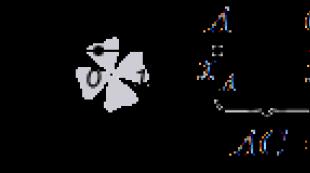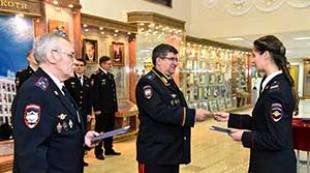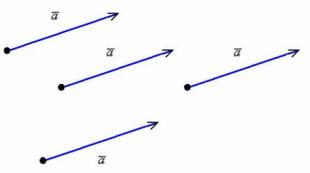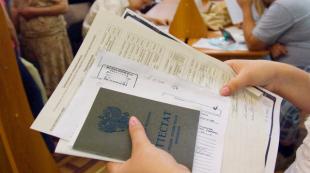Liberation of Crimea May 12, 1944. Crimean operation. Combat map
Exactly 70 years ago, on March 16, 1944, the headquarters of the Supreme Commander-in-Chief ordered the start of the Crimea liberation operation. The Crimean operation itself was carried out from April 8 to May 12, 1944 by the forces of the 4th Ukrainian Front and the Separate Primorsky Army in cooperation with the Black Sea Fleet and the Azov military flotilla.
On May 5-7, 1944, the troops of the 4th Ukrainian Front (commander - General of the Army F.I. Tolbukhin) stormed the German defensive fortifications in heavy battles; On May 9, they completely liberated Sevastopol, and on May 12, the remnants of the enemy troops on Cape Chersonesus laid down.
I dedicate this photo collection to this significant event, friends.
1. Shelled facade of the Sevastopol Palace of Pioneers after the liberation of the city. May 1944

2. German minesweeper in the bay of Sevastopol. 1944

3. German attack aircraft Fw.190, destroyed by Soviet aircraft at the Kherson airfield. 1944

4. Meeting of Soviet partisans and boatmen in the liberated Yalta. 1944

5. The commander of the 7th Romanian mountain corps, General Hugo Schwab (second from left) and the commander of the XXXXIX mountain corps of the Wehrmacht, General Rudolf Konrad (first from the left) at the 37-mm cannon RaK 35/36 in the Crimea. 02/27/1944

6. Meeting of Soviet partisans in the liberated Yalta. 1944

7. The Soviet light cruiser "Red Crimea" enters the Sevastopol Bay. 11/05/1944

8. The commander of the 7th Romanian mountain corps, General Hugo Schwab (second from left) and the commander of the XXXXIX mountain corps of the Wehrmacht, General Rudolf Konrad (center right) pass by a mortar crew during a review in the Crimea. 02/27/1944

9. The Black Sea squadron returns to the liberated Sevastopol. In the foreground is the guards light cruiser Krasny Krym, behind it is the silhouette of the battleship Sevastopol. 11/05/1944

10. Soviet soldiers with a flag on the roof of the destroyed building Panorama "Defense of Sevastopol" in the liberated Sevastopol. 1944

11. Tanks Pz.Kpfw. 2nd Romanian tank regiment in the Crimea. 03.11.1943

12. Romanian General Hugo Schwab and German General Rudolf Konrad in the Crimea. 02/27/1944

13. Romanian gunners fire from an anti-tank gun during a battle in the Crimea. 03/27/1944

14. The commander of the XXXXIX mountain corps of the Wehrmacht, General Rudolf Konrad with Romanian officers at an observation post in the Crimea. 02/27/1944

15. Pilots of the 3rd Squadron of the 6th Guards Fighter Aviation Regiment of the Black Sea Fleet Air Force are studying a map of the combat area at the airfield near Yak-9D aircraft. In the background is the aircraft of the Guards Lieutenant V.I. Voronov (tail number "31"). Saki airfield, Crimea. April-May 1944

16. Chief of Staff of the 4th Ukrainian Front Lieutenant General Sergei Semenovich Biryuzov, member of the State Defense Committee Marshal of the Soviet Union Kliment Efremovich Voroshilov, Chief of the General Staff Marshal of the Soviet Union Alexander Mikhailovich Vasilevsky at the command post of the 4th Ukrainian Front. April 1944

17. Representative of the Headquarters of the Supreme High Command, Marshal of the Soviet Union S.K. Timoshenko, with the command of the North Caucasian Front and the 18th Army, is considering an operation plan to cross the Kerch Strait. From left to right: Marshal of the Soviet Union S.K. Timoshenko, Colonel General K.N. Leselidze, General of the Army I.E. Petrov. 1943

18. The Black Sea squadron returns to the liberated Sevastopol. In the foreground is the guards light cruiser Krasny Krym, behind it is the silhouette of the battleship Sevastopol. 11/05/1944

19. Soviet boat SKA-031 with a destroyed stern, thrown out at low tide in Krotkovo, waiting for repairs. A boat from the 1st Novorossiysk Red Banner division of sea hunters of the Black Sea Fleet. 1944

20. Armored boat of the Azov military flotilla in the Kerch Strait. Kerch-Eltingen landing operation. December 1943

21. Soviet troops transport military equipment and horses through the Sivash. In the foreground is a 45 mm anti-tank gun. December 1943

22. Soviet soldiers ferry on a pontoon a 122-mm howitzer of the 1938 model M-30 across the Sivash Bay (Rotten Sea). November 1943

23. T-34 tanks on the street of the liberated Sevastopol. May 1944

24. Marines at the arch of Primorsky Boulevard in the liberated Sevastopol. May 1944

25. The Black Sea squadron returns to the liberated Sevastopol. In the foreground is the guards light cruiser Krasny Krym, behind it is the silhouette of the battleship Sevastopol. 11/05/1944

26. Partisans who participated in the liberation of the Crimea. The village of Simeiz on the southern coast of the Crimean peninsula. 1944

27. Minesweeper, Lieutenant Ya.S. Shinkarchuk crossed the Sivash thirty-six times and transported 44 guns with shells to the bridgehead. 1943 year.

28. Architectural monument Grafskaya pier in the liberated Sevastopol. 1944

29. Fireworks at the grave of fellow pilots who died near Sevastopol on April 24, 1944 05/14/1944

30. Armored boats of the Black Sea Fleet carry out the landing of Soviet troops on the Crimean coast of the Kerch Strait to the bridgehead near Yenikale during the Kerch-Eltigen landing operation. November 1943

31. The crew of the Pe-2 dive bomber "For the Great Stalin" of the 40th Bomber Aviation Regiment of the Black Sea Fleet after completing a combat mission. Crimea, May 1944. From left to right: crew commander Nikolai Ivanovich Goryachkin, navigator - Yuri Vasilyevich Tsyplenkov, gunner-radio operator - Sergey (nickname Button).

32. Self-propelled guns SU-152 of the 1824th heavy self-propelled artillery regiment in Simferopol. 04/13/1944

33. Soviet soldiers cross the Sivash in December 1943.

34. Marine sets the Soviet naval flag in the liberated Sevastopol. May 1944

35. Tank T-34 in the street of the liberated Sevastopol. May 1944

36. Transportation of Soviet equipment during the Kerch-Eltigen landing operation. November 1943

37. Destroyed German equipment on the shores of the Cossack Bay in Sevastopol. May 1944

38. German soldiers killed during the liberation of the Crimea. 1944

39. Transport with German soldiers evacuated from the Crimea, moored in the port of Constanta, Romania. 1944

40. Partisans in Yalta. 1944

41. Armored boats. The Crimean coast of the Kerch Strait, most likely a bridgehead near Yenikale. Kerch-Eltigen landing operation. Late 1943

42. Yak-9D fighters over Sevastopol. May 1944

43. Yak-9D fighters over Sevastopol. May 1944

44. Yak-9D fighters, 3rd squadron of the 6th GvIAP of the Black Sea Fleet Air Force. May 1944

45. Liberated Sevastopol. May 1944

46. Yak-9D fighters over Sevastopol.

47. Soviet soldiers pose on a German fighter Messerschmitt Bf.109 abandoned in the Crimea. 1944

48. A Soviet soldier tears off the Nazi swastika from the gates of the metallurgical plant. Voikov in the liberated Kerch. April 1944

49. In the location of the Soviet troops - a unit on the march, washing, dugouts. Crimea. 1944

57. Liberated Sevastopol from a bird's eye view. 1944

58. In the liberated Sevastopol: an announcement at the entrance to Primorsky Boulevard, left over from the German administration. 1944

59. Sevastopol after the liberation from the Nazis. 1944

60. In the liberated Sevastopol. May 1944

61. Fighters of the 2nd Guards Taman Division in the liberated Kerch. Soviet troops began crossing the Kerch Strait following the Germans fleeing the Taman Peninsula on October 31, 1943. On April 11, 1944, Kerch was finally liberated as a result of a landing operation. April 1944

62. Fighters of the 2nd Guards Taman Division in the battles for the expansion of the bridgehead on the Kerch Peninsula, November 1943. With the defeat of the German troops on the Taman Peninsula, the path to the Kerch Strait opened up, which was used by the guardsmen during the landing to capture the bridgehead in the Crimea still occupied by the Germans . November 1943

63. Landing of the marines in the area of Kerch. On October 31, 1943, Soviet troops began crossing the Kerch Strait. As a result of the landing operation on April 11, 1944, Kerch was finally liberated. The severity and fierceness of the fighting during the defense and liberation of Kerch is evidenced by the fact that for these battles 146 people were awarded the high title of Hero of the Soviet Union, and 21 military units and formations were awarded the honorary title "Kerch". November 1943
Commanders
Side forces
Crimean offensive operation- liberation of the Crimean peninsula from the Nazi troops in 1944. As a result of the success in the battle for the Dnieper, important bridgeheads were captured on the shores of the Sivash Bay and in the area of the Kerch Strait, and a land blockade began. The highest German military command ordered to defend the Crimea to the last, but despite the desperate enemy resistance, the Soviet troops managed to capture the peninsula. The restoration of Sevastopol as the main naval base of the Black Sea Fleet dramatically changed the balance of power in the region.
general information
In early November 1943, the troops of the 4th Ukrainian Front cut off the 17th German Army in the Crimea, depriving land communications with the rest of the forces of Army Group A. The Soviet fleet was faced with the task of intensifying actions to disrupt the enemy's sea lanes. At the time of the start of the operation, the main base of the Black Sea Fleet was the ports of the Caucasus.
Combat map
Plans and forces of the parties
The protection of maritime traffic between the ports of Romania and Sevastopol was a task of paramount importance for the German and Romanian fleets. By the end of 1943, the German group included:
- auxiliary cruiser
- 4 destroyers
- 3 destroyers
- 4 minelayers
- 3 gunboats
- 28 torpedo boats
- 14 submarines
more than 100 artillery and landing barges and other small ships. For the transportation of troops and cargo, there were (by March 1944) 18 large transport ships, several tankers, 100 self-propelled landing barges and many small ships with a displacement of over 74 thousand gross tons.
In the conditions of the general superiority of the Soviet fleet, the Headquarters of the Supreme Commander-in-Chief counted on the speedy evacuation of enemy troops. On November 4, 1943, the Black Sea Fleet, commanded by Vice Admiral L. A. Vladimirsky (since March 28, 1944 - Vice Admiral F. S. Oktyabrsky), was instructed to detect evacuation in a timely manner and use all bomber equipment against transports and floating craft. and torpedo aircraft.By mid-December, it became clear to the Soviet command that the enemy did not intend to evacuate troops from the Crimean Peninsula. With this in mind, the tasks of the Black Sea Fleet have been clarified: to systematically disrupt enemy communications, to strengthen the supply of the Separate Primorsky Army.
By this time, the combat structure of the Black Sea Fleet included:
- 1 battleship
- 4 cruisers
- 6 destroyers
- 29 submarines
- 22 patrol ships and minesweepers
- 3 gunboats
- 2 minelayers
- 60 torpedo boats
- 98 patrol boats and small hunters
- 97 boats - minesweepers
- 642 aircraft (including 109 torpedo bombers, bombers and 110 attack aircraft)
fighting
From January to the end of April 1944, the fleet aviation carried out about 70 successful attacks on ships. Several attacks on convoys were carried out by submarines and torpedo boats. The actions of the fleet seriously disrupted enemy transportation to the Crimea. The Soviet fleet attacked the ports of Constanta and Sulina, laid mines in the raids.
While the front line in Ukraine was moving west, the position of the Nazi troops in the Crimea was getting worse and worse. The liberation of the Nikolaev, Odessa region, in which the Black Sea Fleet took an active part, made it possible to relocate part of the forces there. On March 31, the Headquarters of the Supreme High Command approved the procedure for subordinating the fleets and setting tasks for them by a special directive. The Black Sea Fleet was withdrawn from the operational subordination of the fronts and was now directly subordinate to the People's Commissariat of the Navy. Developing a plan for the liberation of the Crimea, the Headquarters refused to use amphibious assault. The enemy organized a powerful defense on the peninsula: he installed 21 batteries of coastal artillery, 50 new minefields, artillery and anti-aircraft systems and other means.
From April 8 to May 12, the Black Sea Fleet carried out an operation to disrupt enemy sea communications between the Crimean Peninsula and the ports of Romania. It was necessary for: first of all, preventing the strengthening of the grouping of enemy troops in the Crimea, and secondly, disrupting the evacuation of the defeated 17th German Army. The goals of the operation were achieved by close cooperation between submarines, torpedo boats and aviation. To destroy ships leaving the ports of Crimea, torpedo boats were used in the coastal zone. Away from the bases off the coast of Romania, submarines fought the convoys. In late April - early May, the use of torpedo boats and aviation was hampered by difficult weather conditions, as a result of which the enemy continued to evacuate until recently. During this period, 102 different ships were sunk and more than 60 were damaged.
Aviation and torpedo boats successfully operated in the days before the storming of Sevastopol, and during the battles for the city. Former chief of staff of the commander of the German naval forces on the Black Sea, G. Konradi: “On the night of May 11, panic began on the berths. . The last enemy convoy approached Cape Khersones, consisting of large transports Totila, Teja and several landing barges. Having received up to 9 thousand people, the ships headed for Constanta at dawn. But aircraft soon sank Totila, while Teja, with strong guards, was heading southwest at full speed. Around noon, a torpedo hit the ship and it sank. From both transports, Konradi claims, about 400 people survived (about 8,000 died).
Simultaneously with active operations on enemy communications, the Black Sea Fleet was solving the problem of its own defense. Soviet ships were still threatened by submarines, to combat which a plan was developed and successfully implemented:
- Aircraft attacked the submarine base in Konstanz
- In the middle part of the sea, aircraft searched for boats on their way to the Black Sea coast of the Caucasus
- Separate sections of coastal communications covered minefields
- Ships and planes guarded transports at the sea crossing
As a result, communications between Soviet ports were not interrupted for a single day.
After the liberation of the Crimea and the northern coast of the Black Sea from Perekop to Odessa, the fleet faced new tasks:
- disruption of communications and destruction of enemy vehicles,
- creating a threat to the enemy's coast
- prevention of the use of the Danube as a defensive means
Results
The rapid offensive of the Soviet ground forces and the active actions of the Black Sea Fleet frustrated the intentions of the Nazi command to systematically carry out the evacuation of troops in the Crimea. A surprise for the enemy was the rapid introduction of rocket launchers into the Navy. Their development, as well as the well-established interaction between boats with rocket weapons and conventional torpedo boats, led to an increase in the efficiency of the fleet. Large losses during the evacuation, especially at the last stage, made a heavy impression on the enemy. For the catastrophe that befell them, the army leadership charged the naval command, and the latter referred to the fact that the fleet had been given impossible tasks.
Consequences
During the period from January to May, the USSR Navy solved important combat missions at sea theaters to assist the ground forces in the offensive, disrupt supplies and evacuate enemy troops blockaded from land. Of decisive importance for the fulfillment of the tasks assigned was the growth of the Soviet economy, which made it possible to constantly increase the strength of the fleets and improve their weapons. The German command sought to keep the coastal bridgeheads at all costs, allocating a significant amount of naval forces and aviation for this. The active actions of the Soviet fleets played their part in frustrating these attempts by the enemy and, in general, the defensive strategy of the enemy military command.
After the liberation of the Crimea and such large bases as Nikolaev and Odessa, the situation on the Black Sea changed radically. Now the combat forces of the fleet were able to support the military operations of the Soviet troops to liberate Romania.
Gallery

Literature
- Grechko, A.A.; Arbatov, G.A.; Ustinov, D.F. and etc. History of the Second World War. 1939-1945 in 12 volumes. - M.: Military Publishing, 1973 - 1982. - 6100 p.
On this day, the offensive operation of the Soviet troops was successfully completed in order to liberate the Crimea from the German troops during the Great Patriotic War.
Source: 1.bp.blogspot.com
The operation was carried out from April 8 to May 12, 1944 by the forces of the 4th Ukrainian Front and the Separate Primorsky Army in cooperation with the Black Sea Fleet and the Azov Flotilla. From the Soviet side, 470,000 people, 5982 guns and mortars, 559 tanks and self-propelled guns, 1250 aircraft were involved. From the German - about 200,000 people, about 3600 guns and mortars, 215 tanks and assault guns, 148 aircraft.
On April 8, at 8.00, artillery and aviation preparation began, with a total duration of 2.5 hours. Immediately upon its completion, the troops of the front went on the offensive, delivering the main blow with the forces of the 51st Army from the Sivash bridgehead. On the same day, the 2nd Guards Army, acting in an auxiliary direction, liberated Armyansk.
For three days, the troops of the 4th Ukrainian Front fought fierce battles and by the end of the day on April 10 broke through the enemy defenses on the Perekop Isthmus and south of Sivash. It became possible to bring to the operational space the mobile formations of the front - the 19th tank corps. To conduct reconnaissance and organize interaction with the infantry, the commander of the 19th Tank Corps, Lieutenant General I. D. Vasilyev, arrived at the observation post of the 63rd Rifle Corps of the 51st Army. There, as a result of an air raid, Vasiliev was seriously wounded and his deputy colonel I. A. Potseluev took command of the corps. Tank units entered the gap in the sector of the 51st Army and rushed to Dzhankoy. 
On April 11, the city was liberated. The rapid advance of the 19th Panzer Corps put the enemy's Kerch grouping under the threat of encirclement and forced the enemy command to begin a hasty retreat to the west.
On the night of April 11, simultaneously with the 19th Panzer Corps, the Separate Primorskaya Army went on the offensive, which, with the support of aviation from the 4th Air Army and the Black Sea Fleet, captured Kerch by morning.
Developing the offensive, the Soviet troops liberated Feodosia, Simferopol, Evpatoria and Saki on April 13, Sudak on April 14 and Alushta on April 15, and on April 16 they reached Sevastopol. An attempt to take the city on the move failed and the Soviet armies began to prepare to storm the city.
It was advisable to unite all the land armies under one command, so on April 16 the Primorsky Army was included in the 4th Ukrainian Front and K. S. Melnik became its new commander (A. I. Eremenko was appointed commander of the 2nd Baltic Front). From April 16 to April 30, Soviet troops repeatedly attempted to storm the city, but each time they achieved only partial success. On May 3, General E. Yeneke, who did not believe in the possibility of successfully defending the city, was removed from his post. The general assault on Sevastopol was appointed by the Soviet command for May 5th. Starting it according to plan, after four days of hardest fighting, on May 9, the troops of the front liberated the city.  On May 12, the remnants of the enemy troops at Cape Chersonese laid down their arms.
On May 12, the remnants of the enemy troops at Cape Chersonese laid down their arms.
Historian Kurt Tippelskirch describes the events of the last days of the battle as follows:
“The remnants of three German divisions and a large number of disparate groups of German and Romanian soldiers fled to the Cape of Chersonesus, the approaches to which they defended with the desperation of the doomed, not for a moment ceasing to hope that ships would be sent for them. However, their stamina proved futile. On May 10, they received the stunning news that the promised loading on the ships was delayed by 24 hours. But the next day they looked in vain on the horizon for saving ships. Squeezed into a narrow patch of land, crushed by continuous air raids and exhausted by attacks by far superior enemy forces, the German troops, having lost all hope of getting rid of this hell, could not stand it. Negotiations with the enemy about surrender put an end to the now senseless expectation of help. The Russians, who in their reports usually did not observe any limits of plausibility, this time were perhaps right in determining the losses of the 17th Army in killed and captured at 100,000 people and reporting a huge amount of captured military equipment.
All the time during the operation, active assistance to the Soviet troops was provided by the Crimean partisans. Detachments under the command of P. R. Yampolsky, F. I. Fedorenko, M. A. Makedonsky, V. S. Kuznetsov violated enemy communications, raided the headquarters and columns of the Nazis, and participated in the liberation of cities. 
During the retreat of the 17th Wehrmacht Army from the Crimea to Sevastopol on April 11, 1944, one of the detachments of the Crimean partisans captured the city of Stary Krym. Thus, the road was cut off by units of the 98th Infantry Division from the 5th Army Corps of the 17th Army retreating from Kerch. In the evening of the same day, one of the regiments of this division came out to the city, reinforced with tanks and assault guns. During the night battle, the Germans managed to capture one of the city blocks (Severnaya, Polina Osipenko, Sulu-Darya streets), which was in their hands for 12 hours. During this time, the German infantry destroyed its entire population - 584 people. Since the conditions of the battle did not allow, as was usually done, to drive the doomed to one place, the German infantrymen methodically combed house after house, shooting everyone who caught their eye, regardless of gender and age.
The Crimean operation ended with the complete defeat of the 17th German Army, only the irretrievable losses of which during the fighting amounted to 120 thousand people (of which 61,580 were prisoners). To this number must be added significant losses of enemy troops during the sea evacuation (during which the Romanian Black Sea flotilla was actually destroyed, having lost 2/3 of the available ship's composition). In particular, the flooding of the German transports "Totila" and "Teia", which is included in the list of the largest in terms of the number of victims of maritime disasters of all time (up to 8 thousand deaths), belongs to this time. Thus, the total irretrievable losses of the German-Romanian troops are estimated at 140 thousand soldiers and officers.
Soviet troops and fleet forces during the Crimean operation lost 17,754 people killed and 67,065 people wounded.
As a result of the liberation of Crimea, the threat to the southern wing of the Soviet-German front was removed, and the main naval base of the Black Sea Fleet, Sevastopol, was returned. Having recaptured the Crimea, the Soviet Union regained full control over the Black Sea, which sharply shook Germany's position in Romania, Turkey, and Bulgaria.
For heroism and skillful actions, 160 formations and units were awarded the honorary names of Evpatoria, Kerch, Perekop, Sevastopol, Sivash, Simferopol, Feodosia and Yalta. 56 formations, units and ships were awarded orders. 238 soldiers were awarded the title of Hero of the Soviet Union, thousands of participants in the battles for the Crimea were awarded orders and medals.
May 2, 1944. 1046th day of the war
May 3, 1944. 1047th day of the war
May 4, 1944. 1048th day of the war
May 5, 1944. 1049th day of the war
May 6, 1944. 1050th day of the war
May 7, 1944. 1051st day of the war
On the same day, the Sugar Loaf height was occupied, covering the entrance to the Inkerman Valley. The troops of the 2nd Guards Army, having captured the Mekenzievy Gory station after a four-hour battle, advanced towards the Northern Bay.
May 8, 1944. 1052 day of the war
May 9, 1944. 1053rd day of the war
May 10, 1944. 1054th day of the war
May 11, 1944. 1055th day of the war
May 12, 1944. 1056th day of the war
May 13, 1944. 1057th day of the war
On May 13, the governments of the Soviet Union, Great Britain and the USA issued a joint statement addressed to the satellites of Nazi Germany - Hungary, Romania, Bulgaria and Finland. The statement spoke of the inevitability of the defeat of the fascist bloc and put forward demands: to stop pernicious cooperation with Germany, to enter into a struggle with it and thereby hasten the end of the war, to reduce the disasters of their countries, their responsibility for the criminal war.
May 14, 1944. 1058th day of the war
May 15, 1944. 1059th day of the war
May 16, 1944. 1060th day of the war
May 17, 1944. 1061st day of the war
May 18, 1944. 1062 day of the war
On May 18, the Soviet government sent a note to the government of Bulgaria regarding the ongoing cooperation between Bulgaria and Germany.
May 19, 1944. 1063rd day of the war
May 20, 1944. 1064th day of the war
May 21, 1944. 1065th day of the war
May 22, 1944. 1066th day of the war
The Soviet government announced the recognition of the Home Rada of the People as a representative of the Polish people.
May 23, 1944. 1067th day of the war
Headquarters of the Supreme High Command. On May 22 and 23, the plan was finalized at the Headquarters of the Supreme High Command
On this day in 1944, the Crimean offensive operation ended. At the beginning of the war, it took the Germans 250 days to capture the heroically defended Sevastopol. Our troops liberated the Crimea in just 35 days. The Crimean strategic offensive operation (April 8 - May 12, 1944) went down in history as one of the most important offensive operations of the Great Patriotic War. Its goal was the liberation of the Crimean peninsula. The troops of the 4th Ukrainian Front (commander General of the Army F. I. Tolbukhin) and the Separate Primorsky Army (General of the Army A. I. Eremenko) conducted the operation in cooperation with the Black Sea Fleet (Admiral F. S. Oktyabrsky) and the Azov military flotilla -Admiral S. G. Gorshkov).
As a result of the Melitopol operation on September 26 - November 5, 1943 and the Kerch-Eltigen landing operation on October 31 - November 11, 1943, Soviet troops broke through the fortifications of the Turkish Wall on the Perekop Isthmus and captured bridgeheads on the southern coast of the Sivash and on the Kerch Peninsula, but released at that time Crimea they failed due to lack of strength. The 17th German Army was blockaded and, relying on defensive positions in depth, continued to hold the Crimea. In April 1944, it included 5 German and 7 Romanian divisions (about 200 thousand people, about 3600 guns and mortars, over 200 tanks and assault guns, 150 aircraft).
Soviet troops numbered 30 rifle divisions, 2 marine brigades, 2 fortified areas (about 400 thousand people in total, about 6000 guns and mortars, 559 tanks and self-propelled guns, 1250 aircraft).
On April 8, 1944, the troops of the 4th Ukrainian Front, with the support of the aviation of the 8th Air Army and the aviation of the Black Sea Fleet, went on the offensive, the 2nd Guards Army captured Armyansk, and the 51st Army went to the flank of the enemy's Perekop grouping, which began to withdraw. On the night of April 11, the Separate Primorsky Army went on the offensive with the support of the aviation of the 4th Air Army and the aviation of the Black Sea Fleet and captured the city of Kerch in the morning. The 19th Tank Corps, introduced in the zone of the 51st Army, captured Dzhankoy, which forced the enemy's Kerch grouping to begin a hasty retreat to the west. Developing the offensive, the Soviet troops reached Sevastopol on April 15-16.
From the memoirs of Marshal A. M. Vasilevsky "The Work of All Life":If you look at the maps of the hostilities of 1855, 1920, 1942 and 1944, it is easy to see that in all four cases the defense of Sevastopol was built in approximately the same way. This is explained by the most important role played here by the natural factor: the location of the mountains, the presence of the sea, the nature of the terrain. And now the enemy clung to points that were advantageous in terms of protecting the city.
But already on the first day of the assault on the Sevastopol fortified region, the enemy suffered a major defeat, was forced to leave the main defensive line and withdraw troops to the inner bypass. To liquidate the defense on it and finally liberate Sevastopol - that was our task for May 9th. The fighting did not stop at night. Our bomber aviation was especially active. We decided to resume the general attack at 8 am on May 9th. From the commander of the 2nd Guards Zakharov, we demanded to eliminate the enemy on the northern side of the city in a day and go to the coast of the Northern Bay along its entire length; with the left-flank corps, strike at the Ship Side and take it. The commander of the Primorsky Army, Melnik, was ordered to capture the Nameless Hill southwest of state farm No. 10 by night infantry operations and ensure the entry into battle of the 19th tank corps.
Exactly at 8 o'clock the 4th Ukrainian resumed the general assault on Sevastopol. The battles for the city continued all day, and by the end of it, our troops reached the defensive line prepared in advance by the enemy from Streletskaya Bay to the sea. Ahead lay the last strip of Crimea, which still belonged to the Nazis, from Omega to Cape Khersones.
On the morning of May 10, the order of the Supreme Commander-in-Chief followed: “To Marshal of the Soviet Union Vasilevsky. Army General Tolbukhin. The troops of the 4th Ukrainian Front, with the support of massive air and artillery strikes, as a result of three days of offensive battles, broke through the heavily fortified long-term defense of the Germans, consisting of three lines of reinforced concrete defensive structures, and a few hours ago stormed the fortress and the most important naval base on Black Sea - the city of Sevastopol. Thus, the last center of German resistance in the Crimea was liquidated and the Crimea was completely cleared of the Nazi invaders. Further, all the troops that distinguished themselves in the battles for Sevastopol were listed, which were presented for the assignment of the name of Sevastopol and for awarding orders.
On May 10, the capital of the Motherland saluted the valiant troops of the 4th Ukrainian Front, who liberated Sevastopol. The goals of the operation were achieved. Soviet troops broke through the defense in depth on the Isthmus of Perekop, the Kerch Peninsula, in the region of Sevastopol and defeated the 17th field army of the Wehrmacht. Its losses on land alone amounted to 100 thousand people, including over 61,580 prisoners. Soviet troops and fleet forces during the Crimean operation lost 17,754 people killed and 67,065 people wounded.
As a result of the Crimean operation, the last major enemy bridgehead that threatened the rear of the fronts operating in the Right-Bank Ukraine was eliminated. Within five days, the main base of the Black Sea Fleet, Sevastopol, was liberated and favorable conditions were created for a further attack on the Balkans.









